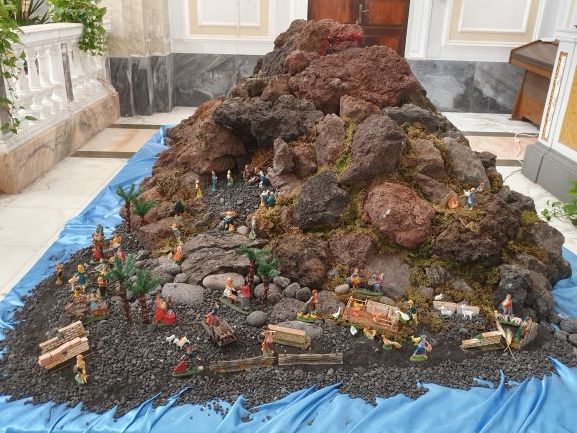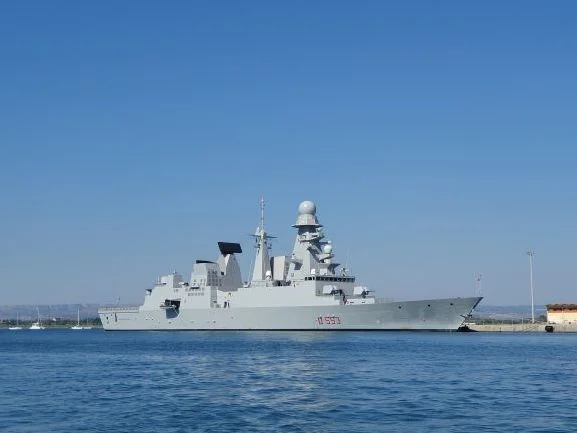Italy - Sicily & the Ionian Sea
The volcanic and windy Aeolian Islands were named after Aeolus, a demigod and keeper of the winds who gave Ulysses the west wind to take him back to Ithaca. Isola Stromboli - so exciting to be here! Unfortunately an eruption and death the week before meant that a three hour slog to the top was out of the question so we settled for a more leisurely evening tender to the north of island to watch nature’s fireworks in action, red lava rivers, tumbling rocks and explosive booming. Next day tendered to the island – pumice and black sand beach, hot and humid with intermittent black grit showers landing on our lunch at Luciano’s – the best pizza ai frutti di mare to date (surpassing my pizza aux fruits de mer in Cannes last season) and the best nativity scene I have ever seen in Chiesa di San Vincenzo, who knew that Jesus was born on Stromboli!
Isola Lipari, largest of the islands with an acropolis and amazing museum. The acropolis site has been occupied since 6000 BC with various owners - Phoenicians, Carthaginians, Greeks, Romans, Arabs, Normans….obsidian and the island’s strategic location playing a big part in its early and continuing occupation. Anchoring was difficult and we were asked to take (pay for) a mooring, the water quality was poor - jellyfish and floating brown pumice – so snorkelling was definitely optional, water 26 degrees, air temp 34.
With six guests on board, all of whom were leaving from Sicily from different airports and at different times, we decided to circumnavigate clockwise starting with the Strait of Messina. It is a narrow funnel-shaped stretch of water that connects the Ionian and Tyrrhenian Seas, its width varying from 1.6 to 8.6 nautical miles, so naturally experiences strong winds and currents. We were lucky with both wind and current and spent our time marvelling at the swordfishermen in their crazy boats - men up high on the mast and far out on the elongated bowsprit attempting to harpoon fish caught in whirlpool currents.
Sicily – an abundance of Greek, Arab-Norman and Baroque architecture, huge Greek amphitheatres and temples, Norman cathedrals built on Moorish mosques and flamboyantly ornate Baroque churches and palazzi. We had been told that the east coast was the best, but really it was all good, just a different take on a recurring theme - fascinating points in history, magnificent architecture, swimmable water, fresh seafood, good local wine and sweet sun-ripened vegetables. Plus we had friends to share it all with!
Eastern hilltop Taormina, anchoring at the foot of a switchback path up to old town, it was either a hot climb up the path or a longer, but more leisurely, tender then funicular up to old medieval Taormina - lush public gardens complete with Victorian follies, Teatro Antico di Taormina, an ancient Greco-Roman theatre still used today, Mt Etna framed in the archways, and a popular destination in the 19th and early 20th centuries for expatriate artists, writers and intellectuals… Oscar Wilde, Friedrich Nietzsche, Richard Wager; D.H. Lawrence was supposedly inspired to write Lady Chatterley’s Lover here. Tender to dinner at Naxos, original Greek city before Taormina and a sad farewell to Pete and Nicky, the cucina would never be the same again.
Ortygia island, Siracusa - hometown of Archimedes and where he met his death by invading Romans. A chance encounter with delightful designer Claudia and her daughter Guilia led to us being introduced to a local artist, Salvatore Accolla, I had spied his work on street barricades in the town and then in their clothes design shop – I love his simple colourful art and bought several pieces. While we were there an Italian stealth ship Andrea Doria crept in and berthed behind the Sea Shepard…boat porn.
South coast – around Capo Passero the coastline was long, dry and sandy, some plastic covered horticultural slopes, hillside cimiteries, limestone cliffs, earthen coloured boxy houses, wind turbined ridges, fishing towns and the sea temperature dropped from 26 to 19 degrees. Another sad farewell, this time to Greg and Maggie at San Leone, we are so lucky to have adventurous friends. We carried on with Doug and Katy to Sciacca (pronounced shacka), a fishing village with a large fleet, steep walk up brightly tiled steps to old town, churches, Norman castella Luna and a large outdoor market – clothes, bedding, jewellery, electronics, cheap and cheerful. Despite walking many steps in the hot sun we didn’t manage to find statue of San Pietro – patron saint of fishermen.
Selinunte – a wonderful anchorage looking straight up at acropolis ruins, magical in the moonlight. A 270 hectare archaeological park, it is the largest in Europe. Founded in 600 BC, once one of the most important Greek colonies in Sicily, it was crushed in 400 BC by the Carthaginian Hannibal and only survived under Punic rule until 100 BC. After a long hot day wandering the ruins we heard some great music across the bay, so at 2400 across we tendered to listen to Gloria belting out some good jazz, blues and country covers, a quiet margherita and chat to her proud parents.
West coast – Sicily at a distance is triangular with the west coast a mere 50 nautical miles, starting at the Egadi islands and ending up the Trapani coastline at San Vito Lo Capo. The islands were once covered with pines and goats and although sadly now deforested, are a secret holiday spot for Sicilians – unspoilt, beautiful turquoise water, golden sand and large bream and damselfish schools, best snorkelling since Amalfi. The Trapani coastline is quite dramatic - granite cliffs, marble quarries, brown scrubby slopes, salt pans and green village valleys.
North coast – a morning cruise along Riserva naturale dello Zingaro - seven kilometers of greenish hills with some evidence of scrub fires, steep cliffs, hidden calas and caves, and many walkers along the coast brought us to Castellammare (castle on the sea) - yet another quaint old town of narrow, windy streets but more importantly the birthplace of Joseph Bonanno (Joe Bananas) - American mafioso and original member of the Commission of families. We found better than average craft stalls, a good fruit/vegetable market but no sign of any Cosa Nostra.
Palermo is the capital of Sicily and was a good place to sadly drop off Doug and Katy as well as to get our boat service done. We took a marina berth at Si.ti.mar (our first this season €120) and were well looked after by the managers – they helped to arrange our Volvo and Genset services as well as giving us pointers on what to see in Palermo. It is an old, dirty, noisy town with tall baroque buildings lining streets that seem to run on forever but also is home to the most incredible number of beautiful churches. And while on the subject of churches – the 12th century Arab-Norman cathedral at the base of the headland in Cefalù is quite spectacular - red gold in the evening sun, it was built by Count (King) Roger I of Sicily a Christian Norman adventurer/soldier who conquered the Arabic Emirate of Sicily and founded the County of Sicily in 1071 – fun fact. Cefalù also has a cool, shady medieval wash-house, the Lavatoio Medievale Fiume Cefalino – the river Cefalino flowing through it to the sea, it must be an underground river as we couldn’t see any sign of it in the streets above.
And then we were back at the Strait of Messina, Isolas Vulcano, Lipari and Stromboli in the distance. This time we experienced quite a strong 4-5 knot current against us through the strait and many ferries, it was a bumpy ride down the west Italian coast.
The east coast of Italy is not as popular or populated as the west - although it seems to have endless stretches of golden sands, there are very few places to anchor and the wind blows strongly off the land – for us it meant three long days of sailing, finally!! We had yet to get our mainsail up, the wind this season has either been non-existent or on the nose - a katabatic WNW had us humming along. First day was 35 knot wind gusts, 9.5 boat speed and the Captain and first mate getting our rusty sailing skills un-rusted. We were joined by a very weary little traveller - Hobie the homing pigeon, who after a day of homemade muesli and water thanked us and carried on his journey. Over the next two eight hour days the Captain and I were transformed into a well-oiled machine, sailing along with WNW winds that ranged from 15-25 knots.
Santa Maria di Leuca and Otranto are both popular jumping off places to Greece, unfortunately both with average chandleries and supermercados – but we are managing bit by bit, backpack by backpack, to get our all-important stocks of parmesan, mozzarella, martini rosso and Italian wine up.
Santa Maria di Leuca, a surprisingly small and fascinating town, where the waters of the Adriatic and Ionian Seas mingle and merge - good anchorage just outside marina, lots of grotto tourist boats though. The seaside promenade is lined with Art Nouveau and Moorish styled villas, once the holiday houses of noble or rich families towards the end of the 19th century and the Mussolini Steps - a monumental man-made waterfall, the end of the Puglia aqueduct, the longest in Europe. Mussolini was a keen supporter and ordered the construction of the showpiece – a central rocky waterfall flanked by steps and at the bottom a Roman column. Unfortunately it is only open a few times a year, we missed out.. Met briefly with the local polizia to get a heads up on stamping in and out of Schengen - casually Armani teashirted and helpful.
And now here we are in Otranto where we are waiting to pick up our next guests today – Emily and Nicky in their second season and Libby and Liam, the greenhorns, let the fun and laughter begin….











































